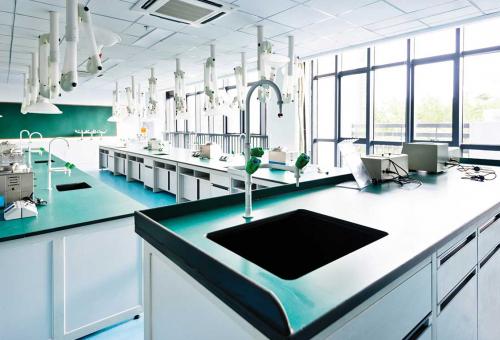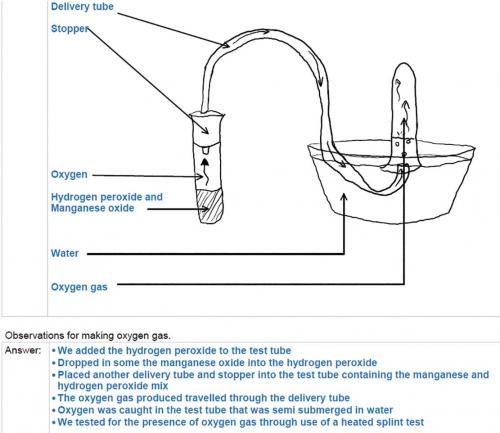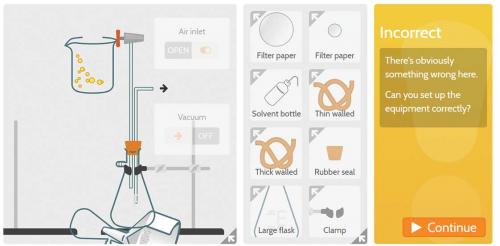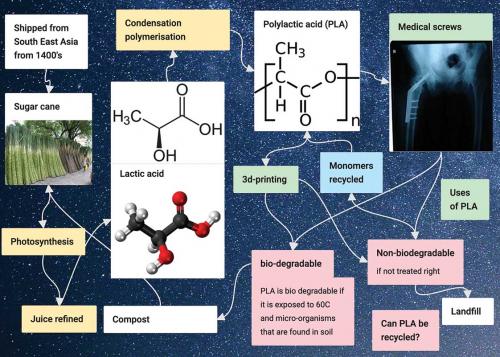Quality teaching involves active, interactive classes; for example, through the use of in-class response systems. Despite the disruptions of COVID-19, in-class polling has been continued by many teachers through online interfaces; this has been supplemented with live chat functions to replace face-to-face interactions. Both secondary and tertiary teachers are running live tutorials and seminars, using screen-sharing applications with integrated polling and quizzes. The following replacements for hands-on practical activities have been adopted as part of remote teaching by both secondary and tertiary teachers in Australia in recent months.
- Students view video recordings of experiments in which they see data being collected. On the basis of the videos, they write observations, complete data analysis and write a report. This has been the most popular emergency response to moving practicals online. Videos were made in the last few days before laboratory closure by teachers, technical and academic staff, demonstrators and others; in some cases, videos had already been made. The length of these videos varies from 10 seconds for critical concepts to 25 minutes for a whole experiment.
- Simulations (e.g. free offerings from PhET Interactive Simulations, the Royal Society of Chemistry or commercial packages) are integrated with structured worksheets to form an assessment task. In many cases, these were already being used as formative assessment tasks.
- Activities at home can replace introductory practicals that emphasise observation and record keeping. This can involve performing ‘kitchen chemistry’ tasks with household items to allow a hands-on experience, or making observations based on a video or other resource, with the option for student choice. The structure of the assessment task must be carefully designed to support skills for later experiments, including drawing flow diagrams, evaluating risks, recording observations and interpreting observations in terms of molecular level explanations.
- Certain chemistry experiments (such as crystallography, molecular modelling and NMR predictions) can be run as live, online practicals with staff explaining while students operate the software.
For all of these delivery modalities, demonstrators or teachers are typically available to answer student questions. When students are required to complete identical online tasks, issues of collusion and cheating arise; however, face-to-face practicals are also susceptible to this.
Approaches in tertiary education
The tertiary context involves large classes (especially at first year) with more than 1000 students in many cases, so solutions must be scalable. Tertiary learning traditionally involves lectures in large groups, which are no longer possible. Institutions have adopted either synchronous online sessions, in order to retain a normal timetable and allow live interaction, or asynchronous recordings to allow maximum flexibility. All universities already recorded lectures so this option is still available to students in any case.
Academic staff were very concerned that students would find it challenging to learn chemistry without the laboratory, which is the best learning environment for chemistry (https://doi.org/10.1021/acs.jchemed.9b00764). We all wanted to maintain a rich learning environment online, but our assessment structures include marks for practicals so these needed to be replaced. Two examples where the existing structure was already blended are detailed below; one opted for a live, timetabled experience while the other chose an asynchronous solution.
At Edith Cowan University, the transition to an online environment commenced in 2018 with the implementation of electronic lab notebooks. For 2020, we ran Virtual Live Lab Classes almost exactly like our face-to-face sessions, using Teams Meetings and OneNote. Video recordings of the experiments were provided. Demonstrators checked attendance, monitored students’ work live online and commented directly within students’ lab reports during the sessions. They could communicate either with all students in the particular ‘bench’ or with individual students. Students could ask questions while completing their lab reports (see example below).
The University of Queensland had already integrated commercial online pre- and post-lab quizzes from Learning Science Ltd, which provided the backbone for the transition to online practicals. These activities included simulations of experimental techniques, practice calculations and data processing (see screenshot below). For 2020, data arrays were created and introduced into post-lab quizzes, replacing students’ data entry. This enabled each student to receive unique data sets, reducing potential collusion opportunities. Resources provided included short annotated videos (less than one minute) of key practical observations with supporting textual notes, and links to a library of interactive simulations. Each practical was open for a week for students to complete in their own time.
Approaches in secondary education
Senior secondary chemistry teachers were given about four days’ notice to design and implement a remote learning program. Complicating matters was a lack of information on changes to the usually strictly enforced, mandated curriculum and assessment procedures. In addition, teachers were acutely aware of inequitable access to online resources, particularly for students in low socioeconomic status and rural schools. Despite these challenges, teachers interviewed over this period reported largely positive experiences, and described a willingness, even after returning to the classroom, to continue utilising the best aspects of online learning to augment the chemistry classroom experience.
Finding a balance of synchronous and asynchronous online experiences in each school was challenging. Most teachers were concerned about their limited ability to have students ‘present’ in online sessions. With an underage cohort, government policies limited which platforms could be used. One experienced teacher, normally confident to teach through class discussion supported by a textbook, felt extremely displaced when told by their leadership team to prepare numerous videos of narrated slides to replace their live teaching.
Most teachers reported that senior chemistry students wanted to engage with their teacher, and were more confident to ask questions, participate in live class discussion and engage in group activities online. One teacher gave an example of running a small group activity across multiple Padlet pages (see example above) in which each group had a space to collaborate on a systems thinking map of a chemical process (https://doi.org/10.1021/acs.jchemed.9b00266). The teacher moved between the different groups and their pages, providing feedback and guidance.
Enhancing practical activities through pre- and post-online engagement
Many teachers described setting meaningful pre-lab activities (e.g. risk assessments, annotating material lists and methods, demonstrating design thinking for scientific investigations) and post-lab activities (e.g. performing calculations with and interpreting second-hand data, and making observations from videos). These activities would normally take up precious laboratory time at school, or be neglected altogether because of time constraints. There was general consensus among the teachers that online pre- and post-activities relating to practical work should be the new normal.
The priority of all teachers in all contexts is always student learning and the student experience. Staff are acutely aware of challenges that many students face in the current situation with job losses and unanticipated changes. Our main goal was to try to minimise stress for students in the transition to online learning without compromising the learning outcomes. Most schools and institutions adopted a combination of the above options, tailored to the content and context. A common theme for replacing laboratory experiences across secondary and tertiary levels has been to emphasise the pre- and post-laboratory activities, which should prepare students for their eventual return to the laboratory. Some of these online activities will be retained beyond the current emergency because they offer valuable contributions to learning. A beautiful part of this stressful time has been the cooperation of the chemistry education community, and the general willingness to share. Some of the shared resources are available at chemnet.edu.au/node/377. The time required to set up a good learning experience and follow up with individual students has been enormous, and sharing approaches can save some effort. Overall, this has actually been positive for the community as a common experience and challenge that has reopened broader communication about laboratory learning.






